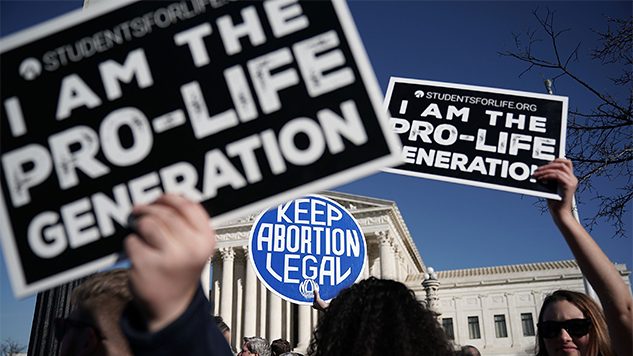Confessions of a Former Anti-Choicer: Lessons Learned On Misinformation and Indoctrination
Photo by Alex Wong/Getty
In his most recent State of the Union address, President Trump denounced a recent New York law and a Virginia bill, both of which permit “late-term abortions.”
“To defend the dignity of every person, I am asking the Congress to pass legislation to prohibit the late-term abortion of children who can feel pain in the mother’s womb,” Trump said.
Needless to say, these are fighting words. I mean that quite literally—the use of the phrase “late-term abortion” is intentionally misleading and inaccurate. When speaking about “pregnancy,” late-term refers to 41 weeks or longer of gestation, a time during which abortions do not occur.
“‘Late-term’ is an invention of anti-abortion extremists to confuse, mislead and increase stigma. The appropriate language is ‘abortions later in pregnancy,’” Dr. Jennifer Conti told CNN.
In fact, the term “abortions later in pregnancy” typically refers to terminations that occur at or after 21 weeks’ gestation. Stats from the U.S. Centers for Disease Control and Prevention show that only 1.3 percent of abortions happen during this span of time, which means, as Dr. Conti notes, that “abortions that occur beyond 24 weeks make up less than 1% of all procedures.” In short, these procedures are rare, and often only occur because the health of the mother is at stake or the fetus has developed a condition that means it will not survive outside of the uterus. When you break down the purposefully manipulative phrase “late-term abortion,” you reveal the truth, which is that abortions later in pregnancy are uncommon products of dire circumstances.
While dissecting this term may seem nitpicky, the language we use around abortion proves vital to how we understand the issue. For years, I was anti-choice, predominantly because of the rhetoric I was fed as a young teenager attending a small parochial Catholic school just outside Seattle. Despite being nestled in the liberal Pacific Northwest, our parish boasted one of the most conservative congregations in the archdiocese and—as if to announce that status—a giant mosaic of a Golden Fetus either floating in space or the sea (my siblings and I could never come to a consensus), like something out of 2001: A Space Odyssey. My older sister claims that she once backed our van into a telephone pole by the church because she was too bewitched by the sight of the Golden Fetus while reversing, and that the subsequent dent was fetus shaped as a result. In truth, she’s just a bad driver, but we loved anything that added to the mythos of the Golden Fetus.

As a part of our anti-abortion education, seventh- and eighth-graders from my school went on the March for Life after a cursory talk from a parish speaker. This woman informed us, in no uncertain terms, that Abortion Is Murder. She compared a fetus to an acorn, telling the class that the acorn is defined by its ultimate purpose: to become a tree. Likewise, she said, we know what a fetus is because, in due time, it will become a person. I drank in every word. As a middle-schooler, I was a straight-A student and a people pleaser. I didn’t question this adult—she was intelligent and well-spoken, and she was essentially indoctrinating impressionable teenagers.
However, Chicago Tribune columnist Steve Chapman aptly pointed out the logical fallacy at the heart of the “abortion is murder” sentiment. He wrote: “If abortion is morally indistinguishable from killing a newborn, though, why shouldn’t those who procure abortions be severely punished? It’s the clear logical implication of the pro-life argument.”
Chapman continues:
But hardly anyone truly regards having an abortion as equal in evil to killing an adult or a child. Hardly anyone thinks a woman who has an abortion belongs in a cell next to a guy who strangles his child.
-

-

-

-

-

-

-

-

-

-

-

-

-

-

-

-

-

-

-

-

-

-

-

-

-

-

-

-

-

-

-

-

-

-

-

-

-

-

-

-








































